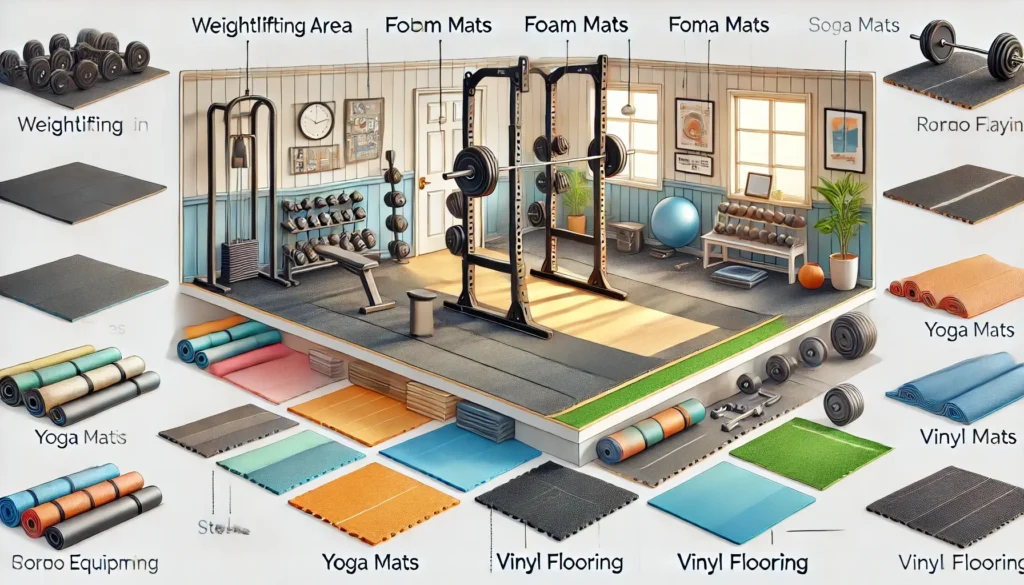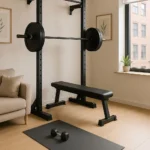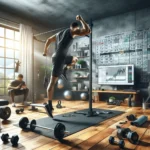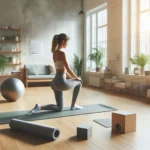Creating a home gym is exciting, but many fitness enthusiasts overlook one crucial element that can make or break their workout experience – the flooring beneath their feet. While you might focus on selecting the perfect equipment, the surface you’re exercising on deserves just as much consideration.
Home gym flooring serves as the foundation for your entire fitness space, providing protection, support, and functionality that regular household flooring simply can’t match. Proper flooring not only protects your existing floor surfaces but also enhances workout safety, reduces noise, and improves exercise performance.
Whether you’re setting up a dedicated workout room, converting your garage, or simply creating a small exercise corner, investing in the right home gym flooring is a decision that will impact every workout session for years to come. This guide will help you understand why quality flooring matters and how to select the perfect option for your specific needs and workout style.
Table of Contents
Understanding Home Gym Flooring Essentials
What Makes Home Gym Flooring Different
Home gym flooring isn’t just an aesthetic choice—it’s specialized surfacing designed to withstand the unique demands of exercise environments. Unlike standard residential flooring, proper gym flooring is engineered to absorb impact, distribute weight, and provide stability during dynamic movements.
The science behind quality home gym flooring focuses on shock absorption and energy return. When you jump during HIIT workouts or drop weights after a heavy lift, your flooring needs to absorb that force instead of transferring it to your subfloor, equipment, or worse—your joints.
Regular household flooring options like hardwood, laminate, or carpet weren’t designed with fitness activities in mind. Hardwood can become damaged from equipment and impacts, carpet lacks stability and harbors moisture, and tile is dangerously hard and slippery when wet. Home gym flooring addresses these shortcomings with materials specifically developed for exercise environments.
Benefits of Quality Home Gym Flooring
Investing in proper home gym flooring delivers multiple benefits that enhance both your workout experience and your home’s integrity:
Protection for Your Existing Floors: Quality gym flooring acts as a protective barrier, preventing damage to your subfloor from heavy equipment, dropped weights, and repeated impact. This protection can save thousands in potential repair costs.
Noise Reduction: One of the most appreciated benefits of proper home gym flooring is noise dampening. The right materials can significantly reduce the sound of footfalls during cardio, the clang of weights, and the vibration of equipment—making your workouts more neighbor and family-friendly.
Enhanced Safety: Gym-specific flooring provides appropriate traction to prevent slips during intense movements or when perspiration hits the floor. Additionally, quality flooring offers cushioning that reduces the risk of injury from falls or joint stress during high-impact exercises.
Improved Performance: The right flooring can actually enhance your workout results by providing the appropriate level of stability, rebound, and support for your specific activities. Whether you need firm footing for strength training or gentle cushioning for yoga, specialized flooring contributes to better form and results.
Moisture Management: Proper gym flooring helps manage sweat and spills, preventing damage from moisture buildup and reducing the risk of mold or odor development—particularly important in basement or garage gyms.
Longevity and Value: While quality home gym flooring represents an upfront investment, its durability typically results in better long-term value compared to repeatedly repairing or replacing damaged conventional flooring.
Types of Home Gym Flooring Options
With numerous options available, selecting the right home gym flooring can feel overwhelming. Here’s a breakdown of the most popular choices and their best applications:
Rubber Flooring

The gold standard for home gym flooring, rubber offers excellent durability, impact absorption, and weight support. Available in tiles, rolls, or mats, rubber flooring comes in varying thicknesses (typically 1/4″ to 3/4″).
- Best for: Weight training, heavy equipment, multipurpose gyms
- Considerations: Higher cost, potential initial odor, heavier to install
Foam Puzzle Mats
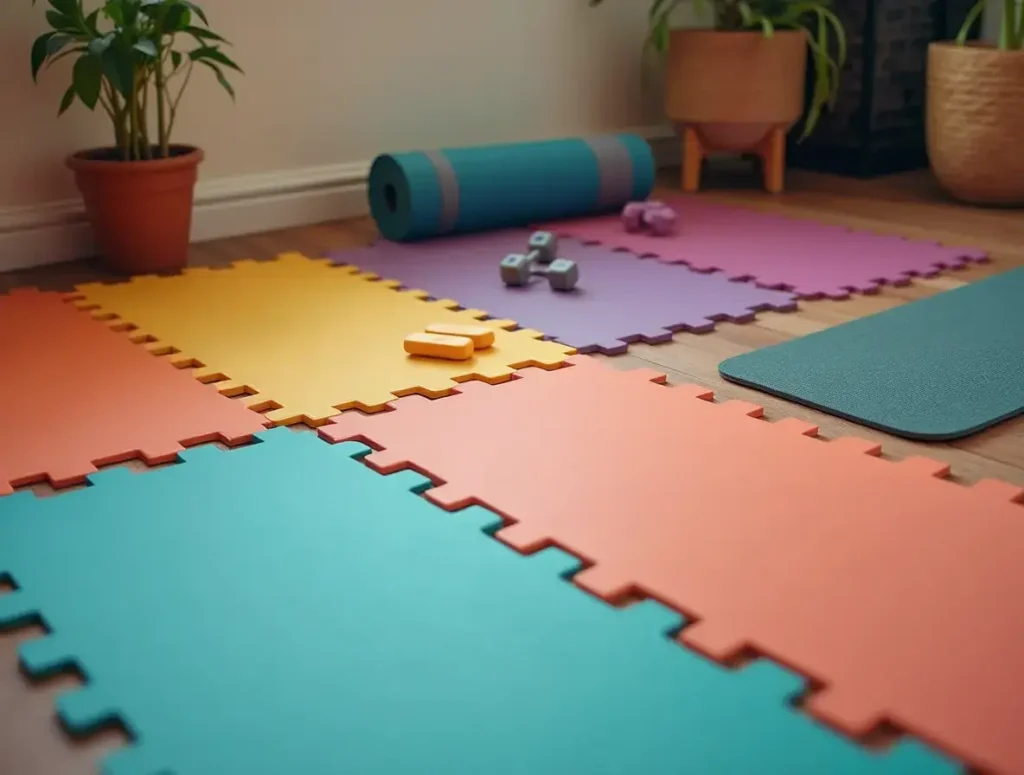
Interlocking foam tiles offer an affordable, lightweight option that’s easy to install and reconfigure.
- Best for: Low-impact activities, bodyweight exercises, temporary setups
- Considerations: Less durable than rubber, can compress under heavy weights, may separate during intense movements
Vinyl Flooring
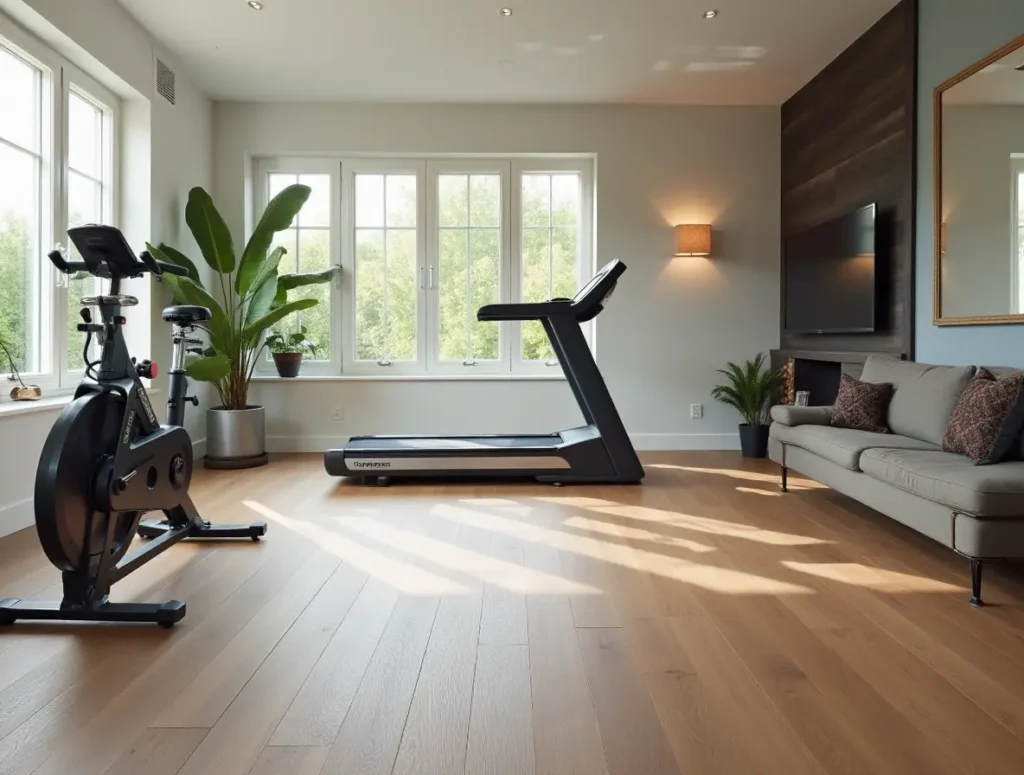
Offering a balance of durability and affordability, vinyl gym flooring provides good moisture resistance and comes in various designs.
- Best for: General fitness, light equipment, multi-purpose spaces
- Considerations: Less impact absorption than rubber, requires completely flat subfloor
Cork Flooring: A natural alternative with good shock absorption and antimicrobial properties.
- Best for: Yoga, Pilates, barefoot workouts
- Considerations: Can dent under heavy equipment, higher maintenance requirements
Horse Stall Mats: A budget-friendly alternative to commercial rubber flooring, these dense rubber mats offer excellent durability.
- Best for: Garage gyms, weightlifting, heavy equipment
- Considerations: Strong initial odor, heavy to transport, limited aesthetic options
How to Choose the Right Home Gym Flooring
Selecting the ideal home gym flooring requires evaluating several factors specific to your situation:
1. Assess Your Workout Style The type of exercise you primarily do should heavily influence your flooring choice:
- For heavy weightlifting: Thick rubber flooring (minimum 3/8″)
- For cardio and HIIT: Shock-absorbing flooring with good rebound properties
- For yoga and floor exercises: Comfortable, supportive surfaces with good traction
- For mixed workouts: Consider combination solutions or multi-purpose rubber
2. Evaluate Your Space Your existing room conditions matter significantly:
- Square footage determines your budget and installation approach
- Basement installations require moisture barriers underneath flooring
- Second-floor gyms need superior sound dampening properties
- Temporary spaces benefit from modular, removable solutions
3. Consider Installation and Maintenance Be realistic about installation complexity and ongoing care:
- Rubber rolls offer fewer seams but require multiple people to install
- Interlocking tiles allow DIY installation but may separate over time
- Permanent adhesive installations provide stability but limit future changes
- Different materials have varying cleaning requirements and chemical sensitivities
4. Budget Appropriately Pricing varies widely across home gym flooring options:
- Basic foam mats: $1-2 per square foot
- Mid-grade rubber tiles: $2-4 per square foot
- Premium rubber flooring: $4-7+ per square foot
- Remember to factor in underlayment, adhesives, and installation tools
5. Address Health and Environmental Concerns Consider these often-overlooked factors:
- Some rubber flooring has strong initial odors (VOCs) that may require ventilation
- Recycled rubber options provide environmental benefits
- If allergies are a concern, look for hypoallergenic materials
- Antimicrobial treatments can help in humid environments
Installation and Maintenance Best Practices
Installation Tips: For successful home gym flooring installation:
- Acclimate your flooring material to room temperature for 24-48 hours before installation
- Ensure your subfloor is clean, dry, level, and structurally sound
- Use appropriate underlayment for additional moisture protection or sound dampening
- Leave appropriate expansion gaps around room perimeter for floating installations
- Consider professional installation for permanent solutions or large spaces
Maintenance Requirements: Proper care extends the life of your home gym flooring:
- Vacuum or sweep regularly to remove abrasive debris
- Clean spills promptly to prevent staining and moisture damage
- Use manufacturer-recommended cleaning solutions—harsh chemicals can degrade many flooring materials
- Place equipment mats under heavy machines or frequently used areas
- Periodically check and reseal seams in modular flooring systems
Optimizing Your Home Gym Flooring Decision
Creating Specialized Zones
For comprehensive home gyms, consider creating dedicated zones with different flooring types:
- Olympic lifting areas with extra-thick rubber and possibly platform construction
- Cardio zones with shock-absorbing, anti-fatigue properties
- Stretching/recovery areas with comfortable, warmer surfaces
- Equipment zones with reinforced flooring under heavy machines
This zoned approach allows you to optimize both function and budget, placing premium materials only where truly needed.
Sound Management Strategies
If noise control is a primary concern for your home gym flooring, consider these enhancements:
- Use acoustic underlayment beneath your primary flooring
- Install rubber flooring in thicker profiles (1/2″ or greater)
- Create floating floor systems that minimize structure-borne sound transmission
- Add wall and ceiling acoustic treatments to complement your flooring sound reduction
Climate Considerations
Environmental factors significantly impact home gym flooring performance:
- Garage gyms in fluctuating temperatures require flooring that can expand and contract
- Humid environments need moisture-resistant materials and potential dehumidification
- Basement installations typically require vapor barriers regardless of flooring choice
- Direct sunlight exposure can fade and degrade certain flooring materials over time
Advanced Home Gym Flooring Strategies
For those looking to create truly optimized workout spaces, consider these advanced approaches:
Custom Platform Construction For serious weightlifters, especially those performing Olympic lifts or deadlifts, consider building a dedicated lifting platform. These typically feature:
- A plywood base for stability
- Rubber side sections for weight landing zones
- An optional center strip of hardwood for foot positioning
- Frame construction that distributes force across a wider floor area
Integrated Equipment Anchoring Some advanced home gym flooring systems allow for:
- Recessed anchor points for securing equipment
- Cable run channels beneath the flooring
- Integrated power supply pathways
- This can create a cleaner, safer gym environment with fewer tripping hazards
Layered Systems Professional-grade installations often utilize multiple layers:
- Moisture barrier foundation
- Acoustic underlayment
- Impact absorption layer
- Performance surface layer While more expensive, these systems provide unparalleled performance and protection.
Conclusion and Next Steps
Your home gym flooring choice forms the literal foundation of your fitness journey. Quality flooring protects your home, enhances your workouts, and creates a safer, more enjoyable exercise environment. Whether you choose basic foam mats for occasional workouts or invest in premium rubber flooring for a dedicated training space, appropriate flooring makes a significant difference in your home fitness experience.
Before making your final home gym flooring decision:
- Measure your space carefully and calculate square footage needs (add 5-10% for waste and cuts)
- Order samples of your top flooring choices to test in your actual environment
- Create a detailed budget including accessories like transition strips, adhesives, and underlayment
- Develop an installation plan, including timeline and assistance needed
- Research proper maintenance routines for your chosen flooring type
Remember that quality home gym flooring is an investment that pays dividends through protected home surfaces, safer workouts, and a more professional exercise environment that can help keep you motivated on your fitness journey.
What home gym flooring questions do you still have? Connect with us in the comments section to discuss your specific setup challenges and solutions. And if you’ve already installed home gym flooring, share your experience to help fellow fitness enthusiasts make informed decisions!
Frequently Asked Questions
What thickness of home gym flooring do I need? For general fitness, 8mm (about 3/8″) flooring typically suffices. For weightlifting, especially if you’ll be dropping weights, choose 3/8″ to 3/4″ thickness. Areas with heavy equipment benefit from minimum 1/2″ thickness to prevent compression damage.
Can I install gym flooring over carpet or tile? While possible, installing over existing flooring often creates problems. Carpet creates an unstable surface under gym flooring, while tile’s hard, uneven surface can cause premature wear. When possible, install directly on the subfloor for best results.
How do I prevent rubber flooring odor in my home gym? New rubber flooring, especially recycled rubber, often has a noticeable odor initially. To minimize this: 1) Unroll and air out the flooring outdoors before installation if possible, 2) Increase ventilation in the space for several weeks, 3) Clean with mild soap and water solution, and 4) Consider low-VOC rubber options if odor sensitivity is a major concern.
Is interlocking gym flooring better than rolled rubber? Each has advantages. Interlocking tiles offer easier DIY installation, the ability to replace individual sections if damaged, and no adhesive requirements. Rolled rubber provides fewer seams (reducing trip hazards and moisture penetration) and typically lower cost per square foot for larger installations.
What’s the best flooring for a multi-purpose fitness room? For spaces that need to accommodate various workout styles, 3/8″ rubber flooring represents the best all-around solution. It’s firm enough for stability during strength training yet provides adequate shock absorption for moderate impact activities.
Do I need professional installation for home gym flooring? Most home gym flooring options are designed for DIY installation. However, professional installation is worth considering for permanent installations, very large spaces, or when custom cutting around irregular room features is required.

